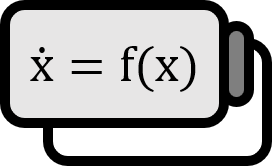Omega Limit Sets of Autonomous Systems
Definition
For a metric space $X$ and function $f : X \to X$, let’s say the following vector field is given by a differential equation. $$ \dot{x} = f(x) $$ Regarding the flow of this system $\phi ( t, x )$ and a point $x_{0} \in X$, if $t_{i} \to \infty$ holds, $$ \phi \left( t_{i} , x_{0} \right) \to x $$ if there exists a sequence of times $\left\{ t_{i} \right\} \subset \mathbb{R}$ that satisfies this, the point is called the omega-limit point of $x_{0}$. The set of omega-limit points of $x_{0}$ is called the omega-limit set of $x_{0}$, and it is denoted as $\omega \left( x_{0} \right)$.
Explanation
In the above definition, when changing only $t_{i} \to - \infty$ to alpha-limit point, alpha-limit set, and so forth, as in $\alpha \left( x_{0} \right)$, alpha and omega are aptly named after the first and last letters of the Greek alphabet, respectively. This reflects that when time goes to negative infinity (the “beginning”), it deals with $\alpha \left( x_{0} \right)$, and when time goes to positive infinity (the “end”), it deals with $\omega \left( x_{0} \right)$. Limit points are translated as accumulation points, and unlike in topology, given a flow, it cares about whether time flows to the past or future. Of course, in most cases, the interest will be in the future, hence the omega limit.
As long as the system we are dealing with is given by ordinary differential equations, the omega limit set with an initial position of $x_{0}$ is likely either a curve or a point. Although it cannot be said that a trajectory formed by a moving point cannot form an area, according to the definition of vector fields, such occurrences should be considered practically impossible.
Properties
Properties of the omega limit set: 1Assume the entire space is Euclidean space $X = \mathbb{R}^{n}$ and that in the flow $\phi_{t} ( \cdot )$, a compact invariant set $\mathcal{M}$ is given.
- [1]: $\omega (p) \ne \emptyset$
- [2]: $\omega (p)$ is a closed set.
- [3]: $\omega (p)$ is invariant under the flow. That is, $\omega (p)$ is a union of orbits.
- [4]: $\omega (p)$ is a connected space.
Of course, these properties similarly apply to alpha limits.
Proof of Property [1]
For $p \in \mathcal{M}$ and $\displaystyle \lim_{k \to \infty} t_{k} = \infty$, define the following set $\Phi (p) \subset \mathcal{M}$ for the sequence of times $\left\{ t_{k} \right\} \subset \mathbb{R}$. $$ \Phi (p) := \left\{ p_{k} : p_{k} = \phi_{t_{k}} (p) \right\} $$ Since $\mathcal{M}$ is compact, by the Bolzano-Weierstrass theorem, there is a subsequence of $\Phi (p)$ that converges to a point of $\omega (p)$, and thus $\omega (p) \ne \emptyset$.
■
Proof of Property [2]
It suffices to show that $\omega (p)^{c}$ is an open set. For any point $q \notin \omega (p)$ outside of $\omega (p)$, there exists a neighborhood $\mathcal{N} (q)$ of $q$ for some $T > 0$ such that $$ \left\{ \phi_{t} (p) : t \ge T \right\} \cap \mathcal{N} (q) = \emptyset $$ holds. In other words, $q$ must be contained in some open set disjoint from $\omega (p)$, and since this $q$ was chosen arbitrarily outside of $\omega (p)$, $\omega (p)^{c}$ must be an open set.
■
Proof of Property [3]
Firstly, assume there exists $\phi_{s} ( q )$ for all $q \in \omega (p)$ and $s \in \mathbb{R}$. This assumption originally requires proof, but it is omitted as it seems insignificant relative to its content. $$ q \in \omega (p) \\ \widetilde{q} := \phi_{s} (q) $$ If $\lim_{k \to \infty } t_{k} = \infty$ is as follows, then choose a sequence of times $\left\{ t_{k} \right\} \subset \mathbb{R}$ such that $\phi_{t_{k}} (p) \to q$. Then, when $k \to \infty$, $$ \phi_{t_{k} + s} (p) = \phi_{s} \left( \phi_{t_{k} } (p) \right) \to \widetilde{q} $$ thus $\widetilde{q} \in \omega (p)$, and so $\omega (p)$ is invariant.
■
Proof of Property [4]
Assume $\omega (p)$ is not a connected space. Then there exists an open set $V_{1} , V_{2} \subset \mathbb{R}^{n}$ satisfying the following. $$ \omega (p) \subset V_{1} \cap V_{2} \\ \omega (p) \cap V_{1} \ne \emptyset \\ \omega (p) \cap V_{2} \ne \emptyset \\ V_{1} \cap V_{2} = \emptyset $$ Let $K := \mathcal{M} \setminus \left( V_{1} \cup V_{2} \right)$ be defined as such. According to the definition of $V_{1}, V_{2}$, the orbit of $p \in \mathcal{M}$ spans both sides of $V_{1}, V_{2}$, and for all $T > 0$, there exists $t > T$ satisfying $\phi_{t} (p) \in K$, so when $k \to \infty$, it is possible to pick a sequence of times $\left\{ t_{k} \right\}$ such that it is $t_{k} \to \infty$ while being $\phi_{t_{k}} (p) \in K$. Because $V_{1}$ and $V_{2}$ are disjoint and neither is disjoint with $\omega (p)$, $\phi_{t}$ cannot stay permanently on either side and must cross over while passing through $K$. Since $V_{1} , V_{2}$ is an open set, $K$ is compact, and according to the Bolzano-Weierstrass theorem, there exists a subsequence of $\left\{ t_{k} \right\}$ converging to $\phi_{t_{k}} (p)$ as $q \in K$, which is $q \notin V_{1} \cup V_{2}$. However, from the definition of the omega limit points, this must be $q \in \omega (p)$, contradicting $\omega (p) \subset V_{1} \cap V_{2}$. Therefore, $\omega (p)$ is a connected space.
■
Wiggins. (2003). Introduction to Applied Nonlinear Dynamical Systems and Chaos Second Edition(2nd Edition): 104~106. ↩︎
